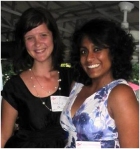 By Minjon Tholen and Heidi Reynolds-Stenson
By Minjon Tholen and Heidi Reynolds-Stenson
An Institute for Women’s Policy Research study analyzing men and women’s earnings over a 15-year span found that women in the prime working ages of 26 to 59 made only 38 percent of what prime working-age men made during the same time span. This major gap is due to occupational segregation, discrimination, caregiving obligations, and other factors, and creates a critical obstacle for women’s economic security throughout their working years and into retirement. Depending on a woman’s socioeconomic status and race/ethnicity, this gap may be even larger. Here are eight things all young women need to know now to be self-sufficient later.
1. Education
Education levels are strongly associated with earnings. The median weekly earnings of bachelor’s degree holders are 65.8 percent higher than those with only a high school degree. Women increasingly recognize the need to further their education and now outnumber men among those graduating with bachelor’s degrees, yet women still earn less than men at every level of educational attainment. Postsecondary education is therefore an important tool for young women to increase economic security over their lifetime.
2. Reproductive Choice
Since educational attainment is a major determining factor of one’s income levels throughout life, and completing high school or college is difficult to combine with child-rearing responsibilities, a woman’s ability to control her own reproductive life is crucial for her economic security. If you are in school and have children, familiarize yourself with and use the student parent support services available in your school and/or community, and advocate for more such services.
3. Occupational Segregation
Many women work in occupations that are traditionally female-dominated and are undervalued and underpaid compared to male-dominated occupations. As of the 1990s, after decades during which occupations increasingly became more ‘mixed’, further gender integration stalled. There are now proportionately fewer women in Information Technology occupations, which are generally well-paid, than there were 15 years ago. As a young woman choosing a career, explore non-traditional career options and keep in mind the implications your career choice may have for your ability to support yourself into the future.
4. Wage Gap
Women also earn less than men within nearly every occupation, indicating that occupational segregation is only part of the story. The gender wage gap begins early (with young women starting off at lower salaries than young men with comparable qualifications in comparable positions), widens over time, and can be larger or smaller depending on one’s race/ethnicity. Part of the problem may be that young women are less likely than young men to negotiate for a higher starting salary or a raise. Also, many employers work to keep pay information confidential; nearly half of all workers say they are either contractually forbidden or strongly discouraged from discussing their pay with their co-workers. Knowledge is power. So, talk to your co-workers, do research on average pay in your industry, and negotiate your salary. Know what you’re worth and ask for it.
5. Discrimination and Harassment
Research indicates that a significant portion of the wage gap within occupations cannot be fully explained by known factors—such as education or experience—suggesting that gender discrimination is still a significant barrier to women’s economic progress. Everyone has a right to a workplace free of discrimination and harassment based on gender or race/ethnicity. Know your rights under the law, familiarize yourself with the policies and protections at your workplace, and speak up when you feel these rights are violated.
6. Work/life balance
Although the majority of women are active in the workforce, they remain the primary caregivers to children and other dependents. Balancing work and personal life can be a struggle for many women and taking time out of work can have a long-term impact on your earnings and job security. Find out whether your employer offers flexible work arrangements and is subject to the Family and Medical Leave Act, in order to know your rights and responsibilities when balancing your work life and personal life.
7. Social Security
Compared to men, women rely on Social Security for a longer period of time (because they live longer) and depend on Social Security for a greater share of their income. Yet, women receive, on average, significantly lower Social Security benefits due to a lifetime of lower wages and periods of decreased employment due to caregiving responsibilities for children, parents, or others. As a young woman, be aware that there is strong likelihood that you will live alone for at least part of your retirement. Educate yourself on how to maximize your Social Security benefits, strive towards ensuring other sources of income in retirement, and work to protect this program which is so vital to so many women and men.
8. Assets, Savings, and Pension Plans
Women face specific barriers to acquiring assets, building up savings, and investing in a pension plan. Women’s lifelong lower earnings due to occupational segregation, the wage gap, and caregiving responsibilities make it difficult to accumulate assets and savings. Women are also significantly less likely than men to have access to and participate in employer-sponsored retirement or pension plans. On top of these factors, women who do receive income from their own pensions receive on average less than half as much as men. To offset reliance on Social Security, start thinking about other ways to supplement your income in retirement early in your life and career.
Be cognizant of how gender inequality impacts your ability to be economically secure. These inequalities are reflected in policies, institutions, and attitudes that affect all of us on a daily basis. Know you have the ability to change this by educating yourself and others, and advocating for women-friendly policies. For in-depth studies on the issues described above and many others, visit the Institute for Women’s Policy Research research portal.
Minjon Tholen and Heidi Reynolds-Stenson are Research Interns at the Institute for Women’s Policy Research
To view more of IWPR’s research, visit IWPR.org

